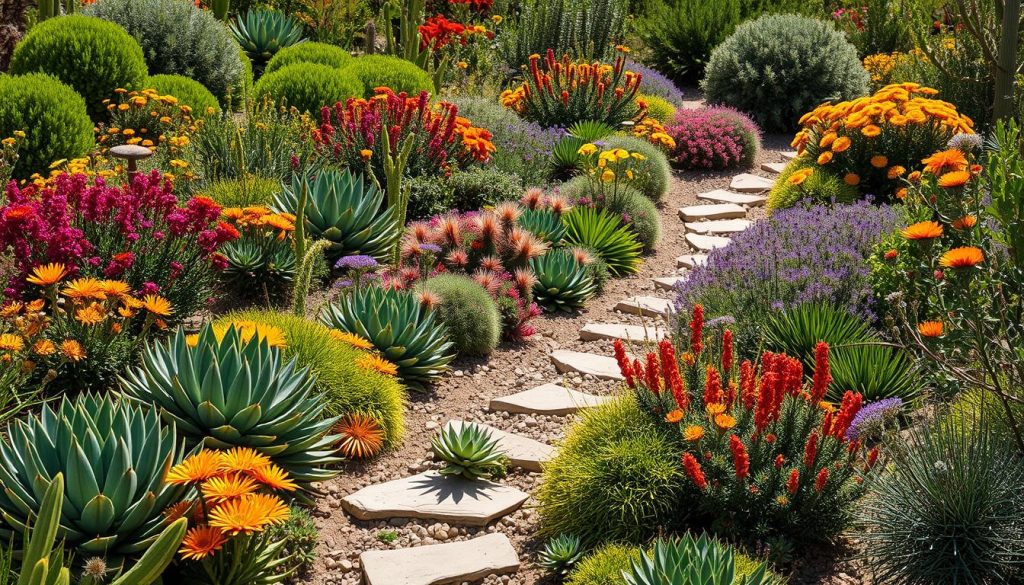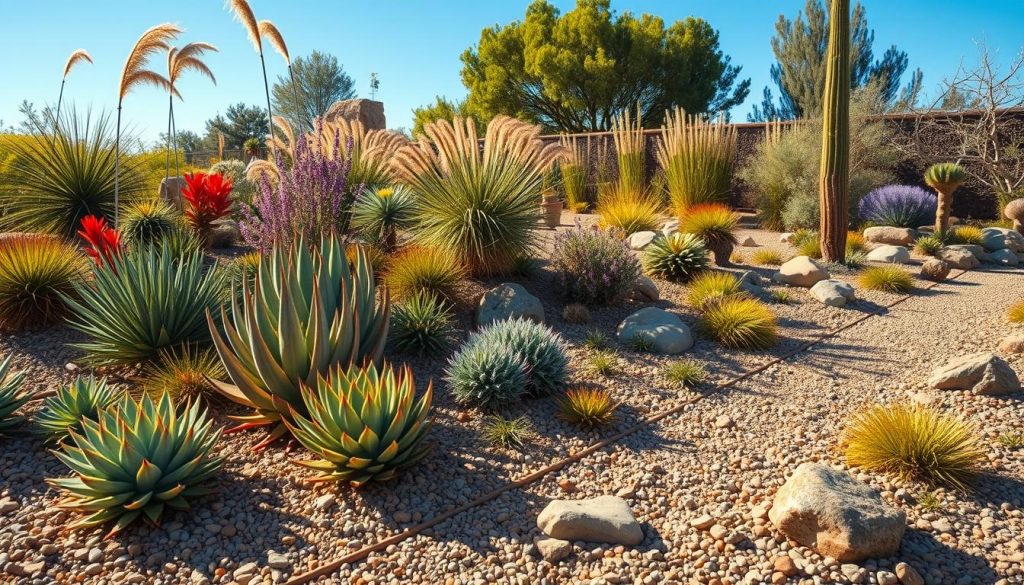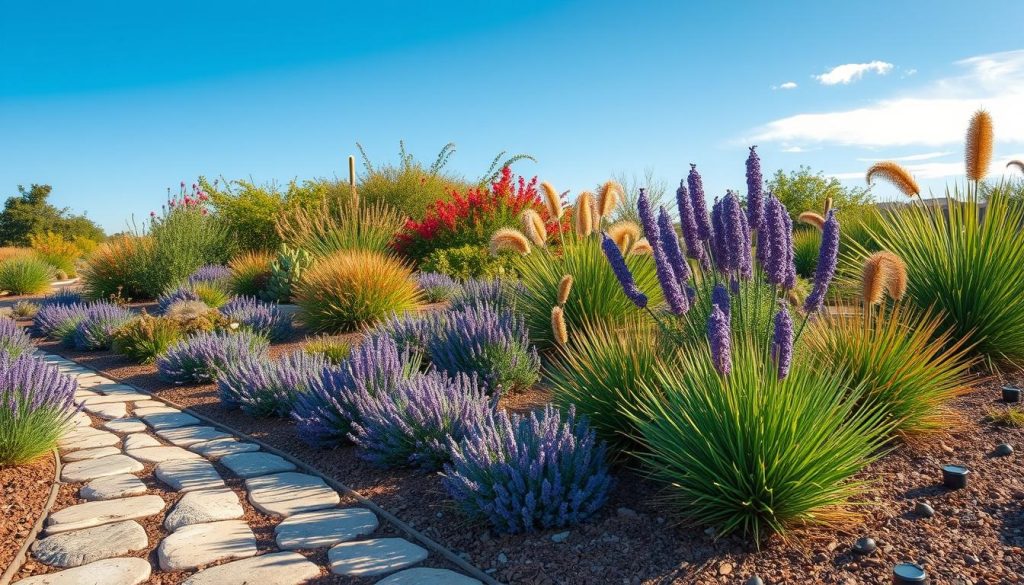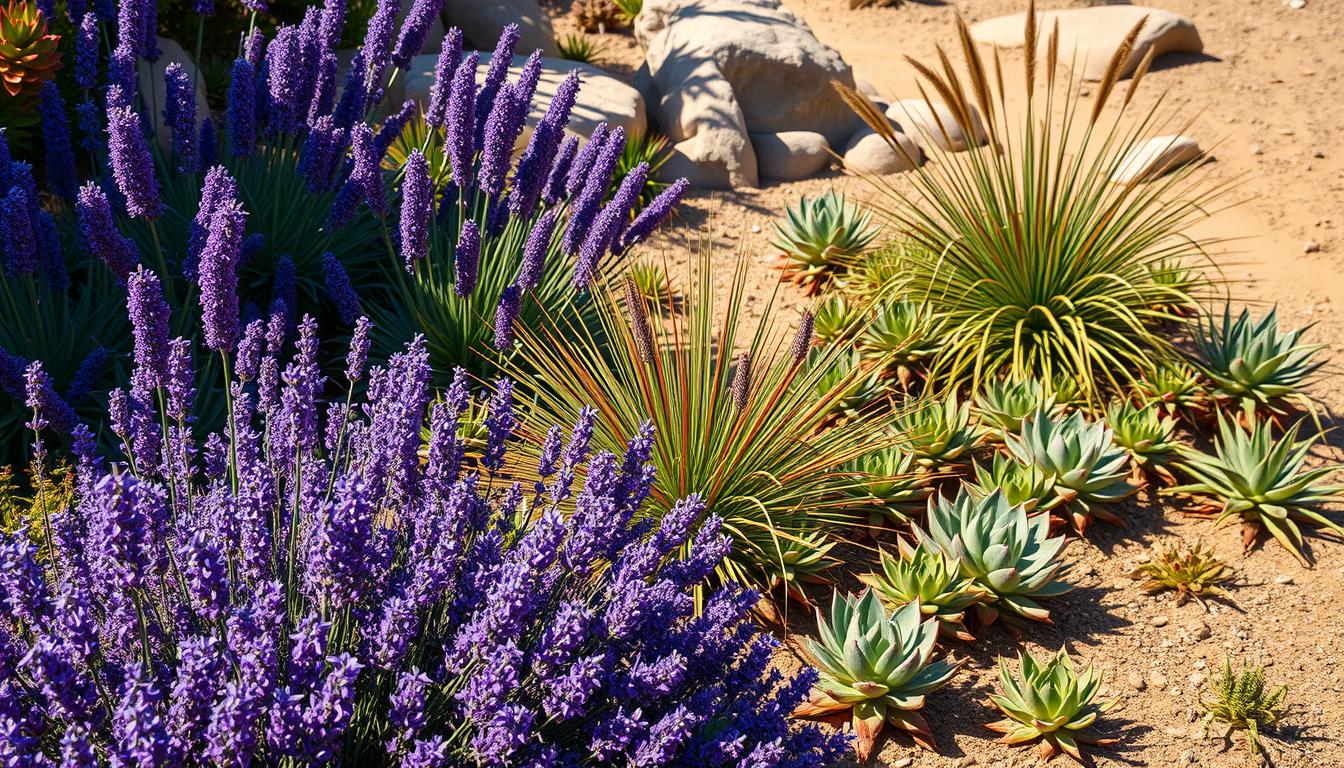I’m excited to share my knowledge about the best drought-resistant plants for my garden. These plants can thrive even in dry conditions. Choosing the right plants helps me keep my garden beautiful while saving water.
Creating a stunning outdoor space means picking the best drought-resistant plants. Drought-tolerant landscaping is good for the environment and saves me money. With the right plants, my garden stays beautiful without needing constant watering.
In this article, I’ll explore drought-resistant plants and share my favorites. We’ll look at succulents and native grasses. These plants make my garden a perfect oasis, even in dry conditions.
Understanding Drought-Resistant Plants
I’m excited to share my knowledge about drought-resistant plants with you. These plants are perfect for gardens that need little care. They have deep roots and waxy leaves, so they need very little water.
One big advantage of these plants is they use less water. This saves water and can also lower your water bill. Plus, they need less care because they’re less likely to get sick or attract pests. This is great for gardeners who are busy but still want a beautiful garden.
What Are Drought-Resistant Plants?
Drought-resistant plants are special because they can live in places with little rain. They have features like deep roots and waxy leaves to save water. These plants are great for places with little rain or for anyone who wants to use less water in their garden.
Benefits of Growing Drought-Resistant Plants
There are many benefits to growing these plants. Some include:
- Less water use
- Less work needed
- More variety in your garden
- Healthier soil
Adding drought-resistant plants to your garden can make it beautiful and easy to care for. They’re perfect for anyone, whether you’re new to gardening or have been doing it for years. They help you garden in a way that’s good for the planet.

Top Drought-Resistant Plants for My Garden
I’ve found many xeriscaping plants that do well in dry conditions. These plants are not only beautiful but also handle heat well. They’re great for gardens that get a lot of sun. I look at soil quality, sunlight needs, and how much care they need when picking plants.
Succulents, native grasses, and perennials are my top picks. They’re made to live in dry places, perfect for gardens with little water. For instance, succulents like aloe and agave store water in their leaves and stems. This lets them go without rain for a long time.
Succulents
Succulents are perfect for gardens that don’t get much water. They come in many shapes, sizes, and colors. They need water only sometimes and a little pruning now and then. Popular types include echeveria, crassula, and sedum.
Native Grasses
Native grasses are also great for dry gardens. They’ve learned to live in local dry conditions. They look good too, with their delicate plumes and leaves adding texture and interest.
Perennials
Perennials like yarrow, coneflower, and black-eyed susan are also good choices. They have deep roots to find water deep in the soil. They’re also pretty, with bright flowers and leaves that make the garden colorful.
Choosing the Right Location in My Garden
Choosing the right spot for water-saving plants and native species is key. I must think about sunlight and soil quality. This ensures my plants grow well and need less care.
I first check how much sunlight my plants need. Most water-saving plants need full sun to partial shade. I look for spots that get at least 6 hours of direct sunlight a day. I also consider the soil type, as some plants prefer certain types.
Sunlight Requirements
- Full sun: 6+ hours of direct sunlight per day
- Partial shade: 4-6 hours of direct sunlight per day
- Full shade: less than 4 hours of direct sunlight per day
Soil Quality Considerations
Soil quality is vital for my plants’ health. I test my soil to see its pH level and nutrient content. By choosing the right spot and preparing the soil, I create a garden that needs less water and care.

Maintaining My Drought-Resistant Garden
To keep my garden thriving, I focus on proper maintenance. This includes using the best drought-resistant plants and drought-tolerant landscaping. This way, my garden stays healthy and beautiful, even when it’s dry.
Watering is key in maintaining a drought-resistant garden. I water my plants deeply but not too often. This encourages deep root growth, helping them survive droughts. Here are some watering tips:
- Water my plants in the early morning or evening to reduce evaporation
- Use a drip irrigation system to deliver water directly to the roots
- Avoid overwatering, which can be detrimental to drought-resistant plants

Mulching is also crucial for my garden. It helps keep moisture in the soil, suppress weeds, and regulate soil temperature. Organic mulch reduces the need for frequent watering, making my garden more sustainable. By using these maintenance techniques, I can enjoy a beautiful garden all year.
Watering Tips
Watering is vital for my drought-resistant garden. By following these tips, I ensure my plants get the right moisture to thrive.
Mulching for Retention
Mulching is a simple yet effective way to keep moisture in the soil. It reduces the need for frequent watering. By applying organic mulch, I create a more sustainable and drought-resistant garden.
Creating a Beautiful Arrangement
When designing my garden, I focus on mixing colors and textures. This makes the arrangement look great. I pick low-maintenance plants that bloom at different times to keep my garden lively all year. Using water-wise gardening methods, like drought-resistant plants and smart irrigation, helps keep my garden beautiful and eco-friendly.
To make a stunning arrangement, I start by picking plants of different heights, textures, and colors. Succulents, native grasses, and perennials are all good choices for easy-care plants. I also think about each plant’s season of interest. This way, my garden stays beautiful all year.
Combining Colors and Textures
- Choose plants with varying bloom times to ensure year-round color
- Select a mix of plants with different textures, such as succulents and native grasses
- Consider the seasonal interest of each plant to create a dynamic arrangement
Seasonal Interest
By using plants with different growth habits and bloom times, my garden stays interesting and beautiful all year. This water-wise gardening approach saves resources and makes my garden a vibrant oasis.
Resources for Further Learning
As we finish our look at drought-resistant gardening, I want to share some great resources. These books and online groups are perfect for both new and experienced gardeners. They offer lots of info and support.
Books on Drought-Resistant Gardening
If you like reading books, check out “The Drought-Resistant Yard” by Pam Penick and “Xeriscape Gardening” by Connie Lockhart Ellefson. These books are full of tips on making beautiful, easy-to-care-for gardens. They cover choosing plants and saving water, helping your xeriscaping succeed.
Online Communities and Forums
In today’s world, gardeners can connect easily online. Sites like the Xeriscape Forum and the Drought-Tolerant Plants subreddit are great places to meet others. Here, gardeners share their stories, ask for advice, and find new ideas.
Whether you like books or online chats, these resources will help you grow your drought-resistant garden. Keep learning and exploring, and you’ll create a beautiful, easy-to-care-for space that does well even in hard conditions.

